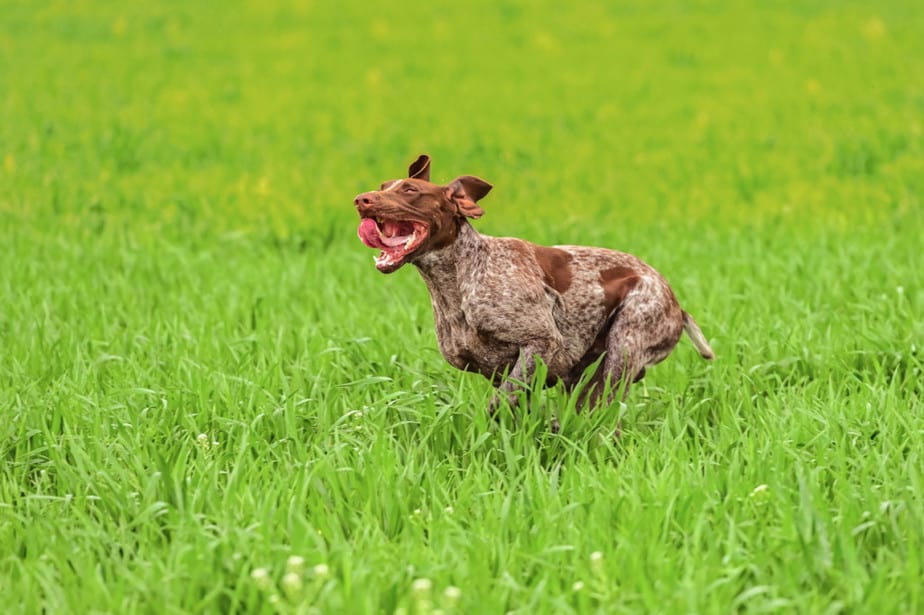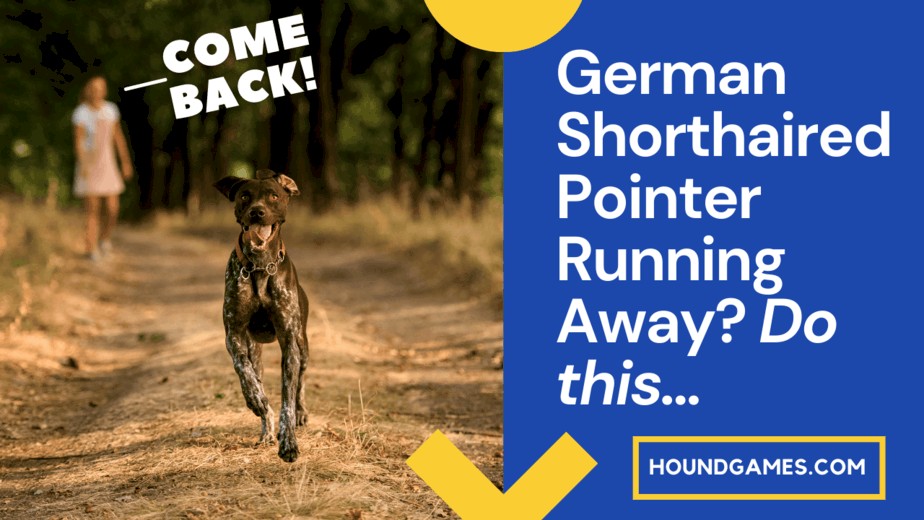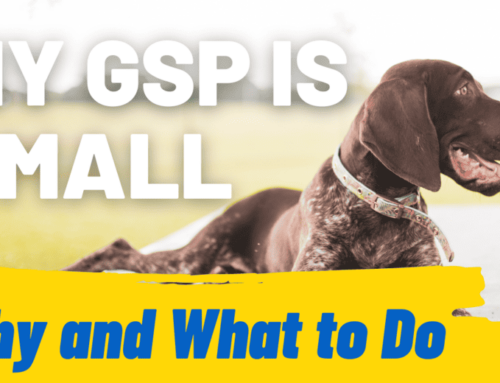The German Shorthaired Pointer is a devoted companion, but moreover, it is a highly versatile sporting and hunting breed.
In fact, the GSP is such a superior athlete that they are often crossed with Alaskan Huskies and Greyhounds to produce some of the world’s best sled dogs. But the need to run (and hunt) can create problems, including a tendency to run away.
So if your GSP is taking off at the drop of a hat, not coming back when you call, or escaping your yard and going on adventures, the first thing to do is to identify why.
Why my GSP runs away
Aside from your German Shorthaired Pointer’s natural inclination to run, there are several reasons you may be having trouble with them running away. These include:
- Boredom or a lack of exercise
- Intact males looking for a mate
- They catch sight or smell something exciting and run off to investigate
- They have not undergone proper obedience training and have learned that responding to the recall is optionable
- They have been frightened by something such as firecrackers
For the GSP, the most common of these reasons is simply their hunting instinct and high-energy levels. Also, they have a superior sense of smell and sight and are easily distracted.
So, while the GSP is highly trainable and loves to please their owner, the scent of a rabbit on the breeze or a rustle in the leaves can have them bounding away like a racehorse out of the starting gates.
The other most common reason is that very few owners really meet their GSP’s exercise needs.
This is not a dog that will be happy with a daily stroll around the block. Frustrated GSPs can quickly become hyper and difficult to control.
If you suspect your GSP is under-exercised, you can check out the German Shorthaired Pointer exercise guide.

How to stop a GSP from running away or escaping
For some of the reasons listed above, the best cure is prevention.
If your German Shorthaired Pointer is an escape artist, then it’s best to invest in higher and more secure fencing on your yard to keep them in.
You can also add coyote rollers to your fence to help keep them from jumping over.
Avoid underground fencing and electronic collars. They have been reported to burn dogs’ necks. It also seems they may increase border aggression as an electronic shock at the wrong time can escalate a dog’s negative reaction.
If you have an intact male that loves to roam around looking for the ladies, you can look into neutering.
And if your GSP has a noise phobia, be sure to keep them safely locked up inside whenever you suspect there might be firecrackers or other loud noises.
It may also be wise to invest in a GPS tracking collar, just in case.
But what about when you take your GSP off-leash on a walk or a hike, and they run away?
In that case, you need to revisit obedience training and not let your dog off-leash until they have a 100% success rate on the recall.
Remember, a good recall can be the difference between life and death, so this is vital training.
You might like to read our post, Lost Dog: How Far Can a Dog Travel When Lost.
Or are you interested in reading this: Will My Dog Jump Out of the Car Window?
How to train your German Shorthaired Pointer not to run away
Preferably, you want to start recall training as young as possible, but it’s never too late!
Here are the basic steps to follow:
-
Start with basic clicker training. Introduce a cue, like your dog’s name, click or make a high-pitched noise every time they give you their attention. Reward with a treat immediately.
-
Do not use the cue to get your GSP’s attention in any other situation where your dog may fail because of a distraction.
-
So, if your cue is “Fido!” then never say it when Fido is running after the neighbor’s cat and has no hope of coming when called.
-
This only lays the foundation that attention is an option, not a must. Instead, introduce a different cue when you need to get their attention but aren’t 100% sure you will get it.
-
Start recall training in an area where your GSP can’t be distracted. Keep them on a long line just in case. Have a treat bag, ball, or favorite tug toy on you to make sure you are the most exciting thing in the environment at all times.
-
If possible, wait for your GSP to be looking at something else, then call their name. Take off running in the opposite direction to engage their chase instinct. You can act a little silly to make it interesting for them. Wave your arms or shake the tug toy around.
-
At first, only introduce the formal cue for the recall when they are actually coming after you. This is to connect the behavior of running to you with the cue.
-
Make sure the cue is not something you would typically use. So if you decide on “come!”, then learn not to use the word in everyday conversation around your dog.
-
Release your GSP with an “okay!” cue immediately after you have rewarded them for coming after you. This teaches them that coming to you won’t be restrictive and ruin their fun.
-
Always reward your GSP for coming, no matter what they were doing or how frustrated you are. If you punish them when they come to you, you will simply teach them that coming when called will result in something bad.
-
As your dog gets better with the recall, you can slowly increase the number of distractions and start trying it out in different places. To begin with, keep your GSP on a long line so that you can check them just in case.
It is easy to make mistakes that can undermine your excellent work when teaching your GSP to come when you call.
What to do when your GSP runs away
While you are training your Pointer’s recall, you may still end up in a situation where your dog has spotted something and taken off.
In this case:
-
Do not chase after your dog. They will only think you are joining in, and this will keep them going.
-
If you have a reliable recall cue, then use it. If not, don’t, as it will only undo your work on your recall.
-
Turn on your heel and walk in the opposite direction. Make a different sound that is not your usual recall cue to get your dog’s attention, like a high-pitched whistle.
-
Stay positive, and don’t let anger creep into your voice. This will only make your GSP reluctant to come to you in case they get punished.
-
Insert a new command. If your dog is good with other obedience commands such as down/stay, give those commands instead to interrupt the action.
-
Play hide and seek. GSPs are naturally attached to their owners, and usually, they quickly lose confidence if their owner is nowhere to be found. Their attention should then switch from whatever they were chasing to finding you instead.
If you take the time to hop behind a tree or rock, your GSP may realize they are alone and backtrack on their own to come to find you. Use your verbal sounds to help them find you. Then make a big fuss when they do.
Are you interested in reading our post, When Will My GSP Start Pointing: (Answered)
My GSP runs away when I approach
If your GSP has learned to leap out of reach when you come closer, this is usually for two reasons.
Firstly, they may be starting a game of “catch me if you can.”
Secondly, and most likely, they have learned to associate being “caught” with being forced to do something they don’t want to do.
This could be something like going home when they want to keep playing or being forced to go outside when they want to stay inside.
They could also have been punished when they came to you once and now they want to keep a healthy distance.
In short, this is usually a trust issue, and trust will need to be rebuilt if you want your GSP to stop running away when you come closer.
Rebuilding trust in a GSP who has learned to stay out of reach takes time and patience, as they can be stubborn when they want to be. While you are in this process, keep your dog leashed on all outings and make sure your yard is entirely secure.
Start by doing the following:
- Teach your German Shorthaired Pointer that coming to you is pleasant and will not mean that they will be grabbed. Give treats or play fetch without ever snatching at their collar.
- Use a toy to encourage them to come closer.
- Let them have the toy (or treat) without forcing them to stay by you.
- Distract them with a bit of obedience, like sit and down, if you can get them to do this without touching them.
- Use this method to gradually recondition your dog into believing that coming to you will not result in anything negative. Only then can you slowly reintroduce the leash.
- At first, only clip the leash on, then clip it off again, reward, release again.
- Avoid any situations where you need to force your dog to do something and rely on positive reinforcement to help them make good decisions independently.
A final word
German Shorthaired Pointers are natural runners, and sometimes that means running away from you. As frustrating as this behavior can be, the good news is that the GSP is a highly trainable dog. This problem is entirely fixable, with a bit of patience and a lot of treats.
The most important thing is don’t get frustrated (as hard as this can be) and remain patient with them. The more positive you are, the more responsive they will be!




